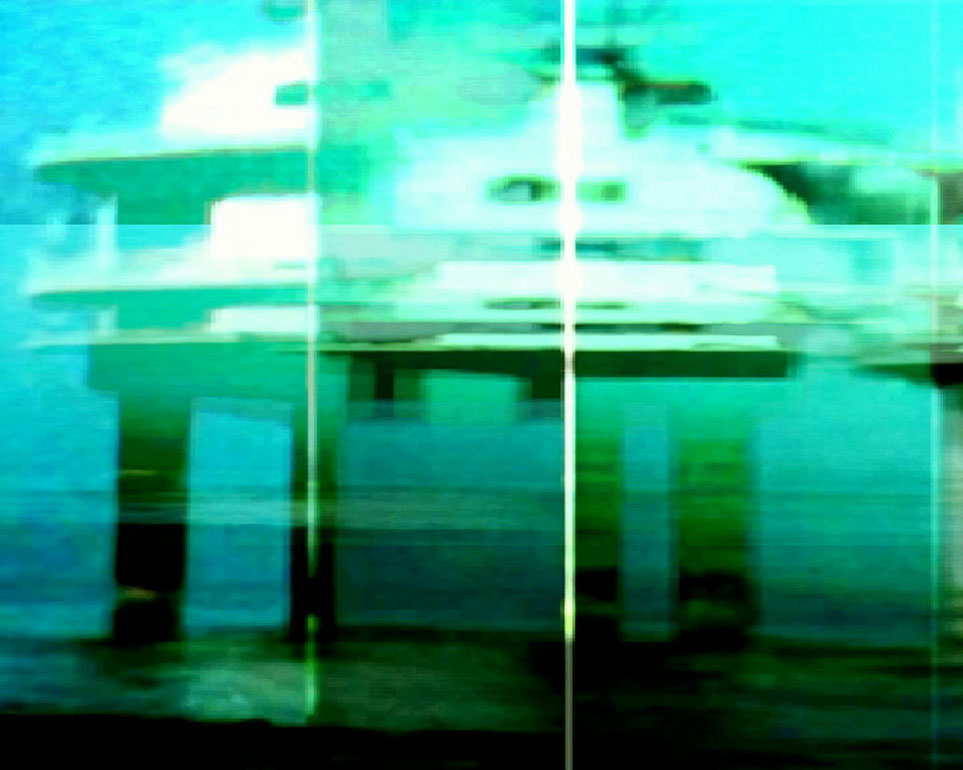tucker
An image is not easy to destroy. It can be split or stretched, blurred or obscured, superimposed over other images or its colors altered. The result will always be an image, possibly less concrete and more difficult to comprehend, but an image nonetheless. Michaela Schwentners tucker begins with a brief report, a message from the machine: A narrow strip of electronically manipulated images flashes in the darkness, accompanied by a few synthetic sounds. This is a signal, though it points the wrong direction: Electronic abstraction is hardly the crux of this work.
After that the image widens as if it first needed to be released, unleashed. A building is shown, plunged into blurriness, anonymous architecture in an unknown landscape, in the colors green and white with a little blue and black. The instrumental pop of Viennese band Le Charmant Rouge provides the nervous visual arrangement with a thoroughly relaxed foundation. White lines, rigidly set horizontally and vertically, structure the complex manipulations of the image, lend some clarity, even order, where at first glance chaos would seem to reign.
The concept of movement is central to this many-layered art music clip: The illusion of an incessant push forward is created by means of montage, in the joining of the images, which themselves seem to be completely motionless. tucker is a work that demonstrates an affinity for abstraction which only peripherally, one could say discreetly refers to the external world. tucker is a film of decay and transformation, a work with uncommon visual power and at the same time a gentle work which deals with shifts in views and aestethicized visual interference. Near its conclusion the artist makes an abrupt switch, a brief plunge into blackness: A yellow field lights up on the left-hand side, to the right a soft red mixes with white and green while the previous conditions are restored in all their beauty.
(Stefan Grissemann)
Translation: Steve Wilder
tucker (texte français)
Par la suite, l'image s'élargit comme s'il avait d'abord fallu la délivrer, la libérer de ses entraves. Elle montre un bâtiment, repoussé dans le flou, une architecture anonyme dans un paysage inconnu, en vert et blanc, avec un peu de bleu et de noir. La musique instrumentale pop du groupe viennois Le Charmant Rouge donne à cet arrangement visuel nerveux une base parfaitement sereine. Des lignes blanches, suivant un schéma horizontal et vertical strict, structurent les manipulations complexes subies par l'image, introduisent la clarté, voire l'ordre, là où semblait à première vue ne régner que la prolifération sauvage.
Ce clip musico-artistique différencié est centré entièrement sur l'idée de mouvement : ce n'est qu'au montage que naît l'illusion d'une irrésistible poussée en avant, dans l'assemblage d'images qui, en soi, paraissent parfaitement immobiles. tucker est une uvre qui penche vers l'abstraction et ne renvoie plus au monde extérieur que marginalement, on pourrait dire : discrètement. tucker est un film de la décomposition et de la métamorphose, une production d'une finesse étonnante compte tenu de la puissance des images, qui s'intéresse au décalage du regard et au brouillage esthétisant de l'image. Vers la fin, l'artiste met en uvre une rupture violente, une chute précipitée dans le noir : un champ de couleur jaune s'illumine à gauche, à droite un rouge atténué se mélange au blanc et au vert, tandis que l'image retrouve son aspect d'origine. (Stefan Grissemann)
Traduction: Françoise Guiguet
tucker
2004
Austria
6 min

